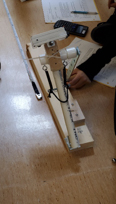Demonstrating Projectile Motion
Projectiles is a major concept in every physics class, but finding a lab activity to demonstrate this concept can be quite difficult. I have tried a number of ideas in the past, such as rolling balls off tables, firing nerf guns (that seem to never shoot consistently), launcher-building competitions, and so many more. While these activities were okay, they were all limited in terms of measurable variables. The projectile problems I give my students often have some sort of initial “launch” velocity, proves to be the hardest thing to measure in a practical setting.
With the Wireless Smart Gate, this is no longer an issue. The Smart Gate will seamlessly measure the speed of any object that passes through it. Now when my students roll a ball off a table, the ball travels through a Smart Gate first giving them the speed at which the ball leaves the table. Before the Smart Gates, students would have to predict the speed of the ball based on the ball’s range, but they never had a value to compare their predictions with. The Smart Gate allowed for a comparison and when students compared their values, they were amazed at how a value calculated on paper translated into a real-world measurement.
Angled launches remained a stumbling block for me. Rolling a ball through a Smart Gate is easy but launching one through? Pasco has angled projectile launchers available to purchase, but I thought I would build my own to see how feasible it would be to have my students eventually build the same. I wanted a product that would launch a ball through the smart gate at various angles so that students could see how the launch angle and speed affects ball flight.
The following pictures are of the finished product. The ball is loaded in the top of the pvc pipe where it rests on a bolt. The bolt is attached to two springs so that when it is drawn back and released, the ball is launched. The video shows the launcher in action. You can see how, as the ball moves through the smart gate, the Smart Gate automatically records the velocity of the ball. The dual beam technology in the new Smart Gate allows for different sized balls to be used, as the velocity is based on the time difference between the two beams. The old photogates only had one beam and you had to calibrate the sensor to the specific size of the object moving through the beam.


Being able to instantly measure the velocity of a projectile before it flies through the air is extremely valuable in the application of this concept. While there are things I would do differently in the construction of the launchers, students were able to see how the different velocities and angles affect the range of the projectile. Once again, students predictions matched measured values closely and they were again amazed at the ability to see this difficult concept in action.
